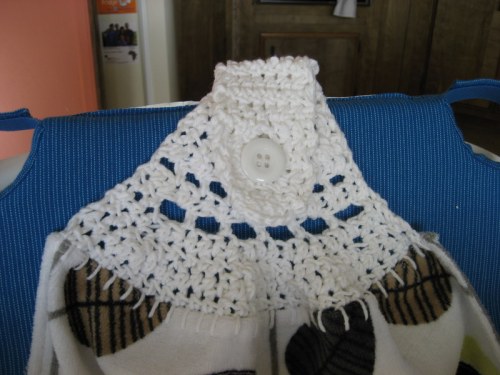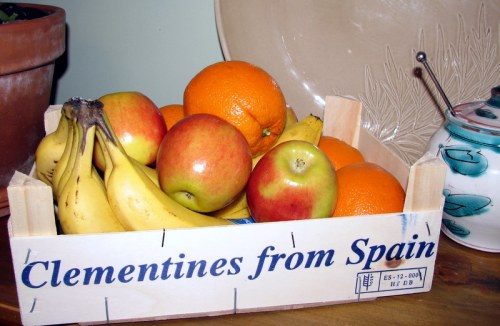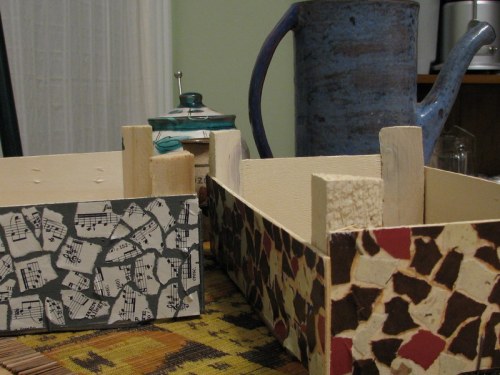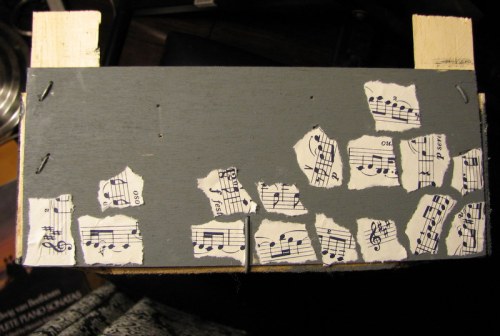 o you like discovering a whole new area of DIY/crafts that you haven’t tried before? Sometimes I am reluctant to get sucked into a new area like that because I’m afraid of how much time and money it will take from my already busy crafting life. But this one – oh, this one is a good one and I’m glad I tried it… Curious?
o you like discovering a whole new area of DIY/crafts that you haven’t tried before? Sometimes I am reluctant to get sucked into a new area like that because I’m afraid of how much time and money it will take from my already busy crafting life. But this one – oh, this one is a good one and I’m glad I tried it… Curious?
I made my first mini-quilt. And loved it. Here it is:
And I feel especially self-congratulatory because I actually got to use the scraps of fabric that we already had, and didn’t have to buy new fabric (as much as I was tempted every time I visited fabric stores in our town).
Being thrifty on the fabric side allowed me a guilty pleasure of buying and enjoying some of the quilting “gadgets.” A rotary cutter, a self-healing mat, and a quilting hoop, for example, made the process of putting together this quilt a little easier.
I pinned this as an inspiration a while ago – it is a zig-zag quilt from liltulip on Etsy:
And here’s the inspiration for the quilt above (by the way, The Purl Bee is an awesome blog full of inspiration and how-tos for sewers, knitters, and crocheters):
Because I’ve never attempted anything like this before, I expected a couple of detours and wrong turns along the way, but everything seemed to have gone very smoothly. Of course, the fun part was putting together the colorful top. It’s amazing to see the colors and the white parts coming together to form a zig-zag pattern. But when I got to hand-quilting the three layers together (the colorful top, the batting and the backing), I found the process particularly meditative. In fact, lately I’ve been finding myself attracted to rather monotonous, repetitive and painstaking processes in crafting – this coming from a usually impulsive and impatient person – who whoulda thunk?
Here’s the backing of the quilt, a cute butterfly print that I embellished with some embroidery details.
Working with the thread and needle like that reminded me of a piece of old-timey advice from a crafter and designer who never stops to uplift and inspire me:
Hold the doubled thread between your thumb and index finger, and run your fingers along it from the needle to the end of the loose tails while saying, “This thread is going to sew the most beautiful garment ever made. The person who wears this garment … will wear it in health and happiness; it will bring joy and laughter.” Continue loving that thread, wishing it all the good that you can think of, and running it through your fingers again and again.
– Natalie Chanin, Alabama Stitch Book
I want this quilt to bring warmth and ease to the little baby who I made it for.







 ometimes, I take months to formulate and execute my creative projects, only to discover that, at the end, I hate the look, the idea, or the execution, or simply the time it took to make something very simple. And sometimes, it just works – there is a raw material or a starting point, there is a perfect idea and the thing is finished in no time. And I’m happy with the results. I wonder if these things happen randomly or if I gravitate towards certain types of creative activities that allow me to move from idea to finished product in a matter of hours or days.
ometimes, I take months to formulate and execute my creative projects, only to discover that, at the end, I hate the look, the idea, or the execution, or simply the time it took to make something very simple. And sometimes, it just works – there is a raw material or a starting point, there is a perfect idea and the thing is finished in no time. And I’m happy with the results. I wonder if these things happen randomly or if I gravitate towards certain types of creative activities that allow me to move from idea to finished product in a matter of hours or days.





 ooking at kitchen designs in my my nesting magazines and blogs recently, I realized that what seems appealing in the summer and spring – the clean-lined, uncluttered counters and stainless appliances – becomes cold and overly sparse in the fall and winter. Instead, I crave a little clutter, spices, fruits and vegetables on display – and some cozy kitchen textiles.
ooking at kitchen designs in my my nesting magazines and blogs recently, I realized that what seems appealing in the summer and spring – the clean-lined, uncluttered counters and stainless appliances – becomes cold and overly sparse in the fall and winter. Instead, I crave a little clutter, spices, fruits and vegetables on display – and some cozy kitchen textiles.




 ometimes the craftiest creative ideas are also the simplest. Enter the old-fashioned and super-easy ivy topiary project.
ometimes the craftiest creative ideas are also the simplest. Enter the old-fashioned and super-easy ivy topiary project.






 or today’s tutorial, I used a very versatile and highly recyclable material available in your nearest grocery store – a clementine crate. You know the boxes made of unfinished plywood used to store the sweet tangerine-like fruit? These sturdy little boxes are wonderful and you can use them for anything from planters
or today’s tutorial, I used a very versatile and highly recyclable material available in your nearest grocery store – a clementine crate. You know the boxes made of unfinished plywood used to store the sweet tangerine-like fruit? These sturdy little boxes are wonderful and you can use them for anything from planters 







